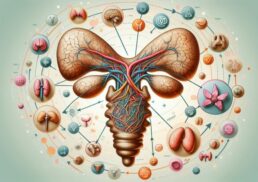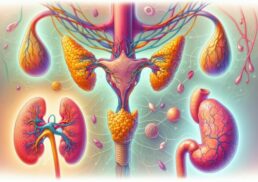Aspiration pneumonia, a potentially life-threatening condition, can be challenging to recognize and manage. This article offers valuable insights into the symptoms, treatment, and prevention of aspiration pneumonia, empowering you to make informed decisions about your health. So, buckle up and get ready for an informative journey through the world of aspiration pneumonia.
In this comprehensive guide, you’ll learn about the early warning signs and risk factors for aspiration pneumonia, the causes and types of this condition, diagnostic methods, treatment options, complications, and prevention strategies. We’ll also discuss the prognosis and recovery process, as well as the importance of interprofessional care and management in ensuring the best possible outcomes for patients.
Table of Contents
Key Takeaways
Recognize early warning signs and risk factors of aspiration pneumonia.
Understand the types, diagnosis methods, treatment options and preventative strategies for successful management.
Interprofessional care is essential to ensure optimal outcomes for patients with this condition.
Recognizing Aspiration Pneumonia
Early identification of aspiration pneumonia is vital to initiate timely intervention and limit potential complications. Recognizing aspiration pneumonia involves understanding early warning signs, such as difficulty swallowing, fever, and hypoxemia, as well as risk factors like altered mental status and neurological disorders.
We will now delve into the early warning signs and risk factors that can assist you in being proactive and vigilant in managing this condition.
Early Warning Signs
Aspiration pneumonia may initially present with sudden onset dyspnea, or difficulty breathing, which can potentially lead to acute respiratory failure. This early warning sign occurs due to the inhalation of oropharyngeal or gastric contents into the lungs, resulting in inflammation and infection.
Additionally, fever is a critical precursor, as it often indicates the presence of an infection of the lungs and should prompt suspicion of aspiration pneumonia.
Radiological findings also play a crucial role in early detection. Bilateral infiltrates, commonly seen in aspiration pneumonia, affect the lungs or large airways.
Paying attention to these early warning signs allows you to act quickly and seek medical help, which could prevent severe complications or even death.
Risk Factors
Comprehending the risk factors for aspiration pneumonia is key to its prevention. Some potential risk factors for developing aspiration pneumonia include:
Altered mental status
Neurological disorders like Guillain-Barre syndrome and Parkinson’s disease
Vomiting
Gastrointestinal obstruction
By understanding these risk factors, you can take steps to prevent aspiration pneumonia.
Vomiting, in particular, increases the risk of aspiration pneumonia due to the potential for inhaled vomit to introduce bacteria and other harmful substances into the lungs. This can result in infection and inflammation, causing symptoms such as:
Chest pain
Coughing
Difficulty breathing
Fever
Awareness of these risk factors enables you to take necessary precautions to minimize the chances of developing aspiration pneumonia.
Causes and Types of Aspiration Pneumonia
Aspiration pneumonia occurs when bacteria typically found in the oral and nasal pharynx are inhaled, which can vary based on the source of the aspirated material. The type of bacteria causing the infection may differ in patients who have been recently hospitalized, and aspiration pneumonia depends on these factors.
The two most common types of aspiration pneumonia are community-acquired and hospital-acquired. We will now examine these types and their distinct characteristics in further detail.
Community-Acquired Aspiration Pneumonia
Community-acquired aspiration pneumonia results from the inhalation of oropharyngeal or gastric contents, typically involving gram-negative bacilli. The incidence rate of aspiration pneumonia in cases of community-acquired pneumonia is 5-15%, and with proper treatment, most patients can survive this condition.
The most frequent causative organisms of community-acquired aspiration pneumonia include:
Streptococcus pneumoniae
Staphylococcus aureus
Haemophilus influenzae
Enterobacteriaceae
These bacteria can cause severe infections in the body, leading to body respiratory failure death in some cases.
Fusobacterium, Bacteroides, and Peptostreptococcus are commonly isolated anaerobes in community-acquired aspiration pneumonia.
Hospital-Acquired Aspiration Pneumonia
Hospital-acquired aspiration pneumonia is associated with an increased risk of complications and mortality, often involving antibiotic-resistant bacteria. The elderly population is particularly susceptible to this condition. Common causative organisms include gram-negative organisms, such as Pseudomonas aeruginosa.
The magnitude of the increase in bacterial pneumonia among residents of continuing care facilities compared to those in the community is three-fold. Being aware of the differences between community-acquired and hospital-acquired aspiration pneumonia can help healthcare providers tailor their approach to diagnosis and treatment.
For more info, visit Healthcare-associated Pneumonia and Aspiration Pneumonia.
Diagnosis and Evaluation
Proper treatment and management of aspiration pneumonia hinge on its accurate diagnosis and evaluation. Healthcare providers use imaging studies and laboratory tests to identify the site of aspiration and the causative organisms, helping them determine the best course of action.
We will now examine these diagnostic methods and their significance in the management of aspiration pneumonia.
Imaging Studies
Chest x-rays and computed tomography (CT) scans play a vital role in diagnosing aspiration pneumonia and assessing the extent of lung involvement. A chest x-ray can show evidence of pneumonia, such as lobar pneumonia, areas of opacity, or inflammation at the bottom of the lungs. It can also help localize the site of aspiration and determine the extent of lung involvement.
Computed tomography (CT) scans provide accurate imaging and can detect abscesses, empyema, and inflammation in the lungs, indicative of aspiration pneumonia. These imaging modalities are effective in identifying the site of aspiration and any associated complications, such as abscess formation, lung necrosis, and empyema, guiding the diagnosis and treatment of aspiration pneumonia.
Laboratory Tests
Blood cultures and sputum analysis help identify the causative organisms and guide antibiotic therapy for aspiration pneumonia. The procedure for obtaining a sputum culture entails:
Instructing the patient to deeply cough and expel the material from the lungs into a sterile cup.
The sputum sample is then taken to a laboratory for analysis.
It is cultured on specific media to foster the growth of bacteria or fungi.
Arterial blood gas assessment is employed to evaluate pH status and oxygenation, while bronchoscopy with a protected brush and protected catheter may be utilized to retrieve pathogens in bacterial pneumonia. The procedure is beneficial in determining if there is a neoplasm blocking anaerobic bacteria causing pneumonia and lung abscess. Without this procedure, it can be difficult to determine the presence of such neoplasms.
Treatment Options for Aspiration Pneumonia
Treatment options for aspiration pneumonia range from antibiotic therapy to supportive care, dictated by the severity of the infection and the patient’s overall health. Swift administration of suitable treatment is paramount for successful recovery and limiting potential complications.
We will now examine these treatment options more thoroughly.
Antibiotic Therapy
Antibiotic therapy is fundamental in treating bacterial aspiration pneumonia, with the choice of antibiotics hinging on the type of bacteria involved and the patient’s overall health. For patients exhibiting a toxic appearance or who have recently been hospitalized, piperacillin/tazobactam or imipenem/cilastatin in combination with vancomycin are recommended. For patients without a toxic appearance, ceftriaxone in combination with azithromycin, levofloxacin, or moxifloxacin is suggested.
It is important to consider the addition of clindamycin or metronidazole to the antibiotic regimen when there is a risk of:
chronic aspiration
putrid discharge
an indolent hospital course
necrotizing pneumonia
Anaerobic bacteria involvement may also be present in such cases.
Prompt administration of the appropriate antibiotics is critical for the successful treatment and helping patients survive aspiration pneumonia.
Supportive Care
Supportive care for aspiration pneumonia includes:
Adjusting patient position
Suctioning oropharyngeal contents
Administering humidified oxygen
Monitoring oxygen saturation
Adjusting the patient’s position helps minimize the risk of further aspiration and promotes better respiratory function. Elevating the head of the bed between 30 and 45 degrees can reduce reflux and the potential for aspiration.
Administering humidified oxygen has several benefits:
Improves oxygenation
Facilitates airway clearance
Diminishes airway irritation
Increases patient comfort
It’s important to monitor oxygen saturation to evaluate the patient’s breathing and oxygenation status. Low oxygen saturation levels below 92% warrant the administration of supplemental oxygen, while more severe cases may require intubation and mechanical ventilation.
Complications and Long-term Effects
Aspiration pneumonia, also known as aspiration pneumonitis, can lead to various complications and long-term effects if not properly treated. Some of the potential complications associated with bacterial aspiration pneumonia include lung abscess and bronchopleural fistula. Aspiration pneumonia can also lead to substantial pulmonary damage and may result in the development of Acute Respiratory Distress Syndrome (ARDS).
Ingestion of gastric or oropharyngeal contents, or material into the lungs, can cause acute pulmonary infection, which can lead to the development of empyema, an accumulation of pus in the pleural space. Comprehending these potential complications and long-term effects is vital in managing aspiration pneumonia and ensuring optimal outcomes for patients.
Prevention Strategies
Prevention of aspiration pneumonia is important to uphold overall health and lower the risk of complications. Proper positioning, swallowing evaluation, and education for patients and healthcare providers can help reduce the risk of aspiration pneumonia. Although no controlled trials have been conducted to determine the effectiveness of body positioning and altering the consistency of food/liquids in mitigating aspiration, these strategies can still be beneficial.
Evaluating swallowing function is conducted to ascertain if the patient has trouble swallowing and may need to employ alternative feeding methods to minimize the risk of aspiration. A speech and language therapist should be consulted for a thorough swallowing assessment in patients who have had a stroke or who possess other risk factors for aspiration. Implementing these prevention strategies can substantially lower the chances of developing aspiration pneumonia.
Prognosis and Recovery
The prognosis and recovery from aspiration pneumonia can vary depending on the severity of the infection, any underlying health conditions, and the patient’s age. Mortality rates for aspiration pneumonia range from 11-30%. In severe cases, mechanical ventilation may be necessary for patients experiencing chemical pneumonitis resulting in ARDS and respiratory insufficiency stemming from aspiration pneumonia.
The expected recovery time for aspiration pneumonia typically takes between 1-4 weeks, although this may be extended depending on the age and other health factors of the individual. Most patients can successfully recover from aspiration pneumonia by taking the right precautions, seeking prompt medical attention, and adhering to treatment plans.
Interprofessional Care and Management
Interprofessional care and management of aspiration pneumonia involve a collaborative effort from a team of healthcare professionals, including primary care providers, infectious disease specialists, radiologists, pulmonologists, and speech-language pathologists. In prehospital care, the primary focus should be on stabilizing the patient’s airway, breathing, and circulation, which may include oxygen supplementation, cardiac monitoring and pulse oximetry, and IV catheter placement and IV fluids, as necessary.
Inpatient care for aspiration pneumonia requires a multidisciplinary approach due to the severity of the illness, host factors, and the unpredictable course and prognosis of the condition. Postdischarge management may involve prolonged antibiotic therapy for anaerobic bacterial infections complicated by empyema or lung abscess, with outpatient treatment being obligatory.
Collaborative efforts among healthcare professionals can ensure the best possible outcomes for patients with aspiration pneumonia.
Summary
In conclusion, aspiration pneumonia is a serious and potentially life-threatening condition that requires a comprehensive understanding of its symptoms, causes, treatment options, and prevention strategies. By recognizing the early warning signs and risk factors, seeking timely medical care, and adhering to the treatment plan provided by an interprofessional healthcare team, patients can successfully recover from aspiration pneumonia and minimize the risk of complications and long-term effects.
As you navigate the complexities of aspiration pneumonia, remember that knowledge is power. Stay informed, take necessary precautions, and work closely with your healthcare team to ensure the best possible outcomes. With the right information and support, you can overcome aspiration pneumonia and maintain your overall health and well-being.
Frequently Asked Questions
What are the first signs of aspiration pneumonia?
The initial signs of aspiration pneumonia are chest pain, coughing with foul-smelling, greenish or dark phlegm, fatigue, fever, shortness of breath, wheezing, breath odor, and excessive sweating.
What are the chances of surviving aspiration pneumonia?
The mortality rate from aspiration pneumonia can range from 21-70%, depending on the volume and content of the aspirate. An observational study has also found that the risk of developing aspiration pneumonia is about 13.8%. However, the chances of surviving it can vary greatly depending on individual circumstances and severity of the disease.
How serious is aspiration pneumonia?
Aspiration pneumonia is a serious and potentially deadly condition. It can lead to lung abscesses, scarring, and even death in untreated cases. It has a mortality rate of up to 70% and can be considered a ‘silent killer’, as it may not have many symptoms.
What is aspiration pneumonia?
Aspiration pneumonia is an infection of the lungs caused by inhaling saliva, food, liquid, vomit and other foreign objects. It can be serious and even fatal if left untreated, but can be treated with appropriate medications. The major features of the lungs include the bronchi, the bronchioles and the alveoli, in which oxygen and carbon dioxide gas are exchanged.
What are the main risk factors for aspiration pneumonia?
Altered mental status, neurological disorders, vomiting, and gastrointestinal obstruction are the main risk factors for aspiration pneumonia.









